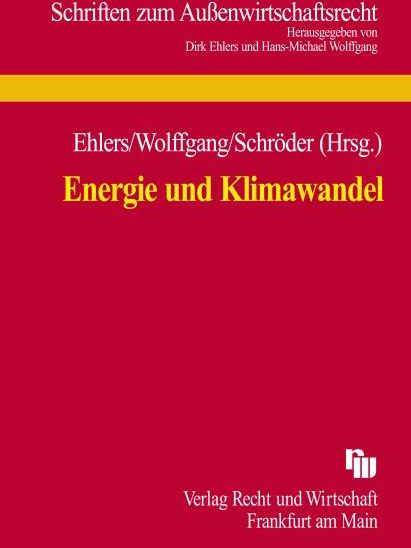
Ökonomische Instrumente zwischen Kyoto und Kopenhagen – Quo vadis Klimaschutz?
- Publication
- Citation
Görlach, Benjamin 2010: "Ökonomische Instrumente zwischen Kyoto und Kopenhagen - Quo vadis Klimaschutz?", in: Dirk; Wolffgang Ehlers, Han-Michael; Schröder, Ulrich Jan (ed.): Energie und Klimawandel: Tagungsband zum 14. Münsteraner Außenwirtschaftsrechtstag 2009. Frankfurt am Main: Recht und Wirtschaft, 125-141.
From 15 to 16 October 2009, the Center for Foreign Trade Law of the Westphalian Wilhelms University in Münster hosted its 14th Foreign Trade Law Day, focusing on energy and climate change. At this conference, Benjamin Görlach, economist for the Ecologic Institute, delivered a presentation entitled "Economic Instruments between Kyoto and Copenhagen: quo vadis Climate Protection?" This presentation is now available as an article in the conference volume.
Economic instruments can be used, and are already being used, in a number of different ways to help address the problem of climate change. First, there are price-based instruments such as taxes on energy and resource use, which raise the cost of consuming fossil fuels or of emitting greenhouse gases. Such taxes are commonly used in a number of OECD countries. Second, quantity-based instruments limit the absolute amount of emissions, and create emission permits that can be traded among the participating installations. The largest of these schemes is the EU Emissions Trading Scheme, which has been in operation since 2005. As other, comparable schemes are being set up in a number of other (industrialized) countries, these schemes could eventually be linked up to form a global carbon dioxide market.
The basic rationale of all economic instruments for protecting the climate is to establish a price on CO2 emissions. Thereby, they address the underlying market failure that – economically speaking – is the root cause for climate change: in making their decisions, economic actors do not factor in the full social cost of their greenhouse gas emissions. By correcting the economic incentives that emitters face, economic instruments are expected to deliver the least-cost reduction options, and thereby achieve the necessary emission reductions at the lowest cost to society. A second key function of economic instruments is to generate revenue – either from taxes or from the auctioning of emission allowances – that can subsequently be used to support further emission reductions.
Benjamin Görlach's book article covers the current role of economic instruments in climate protection; the question whether to use price or quantity control; examples and trends in economic instruments for climate change; and how the Copenhagen Climate Conference affects the use of economic instruments in the international climate regime. His book article complements the other contributions at the conference volume. These book articles focus on topics such as national and European energy politics, energy in light of WTO law, emissions law in developing countries, and various other energy and climate related topics.
This article is published in the volume "Energie und Klimawandel" by the Recht und Wirtschaft Verlag. The presentation [pdf, 1.7 MB, German] is available for download.


